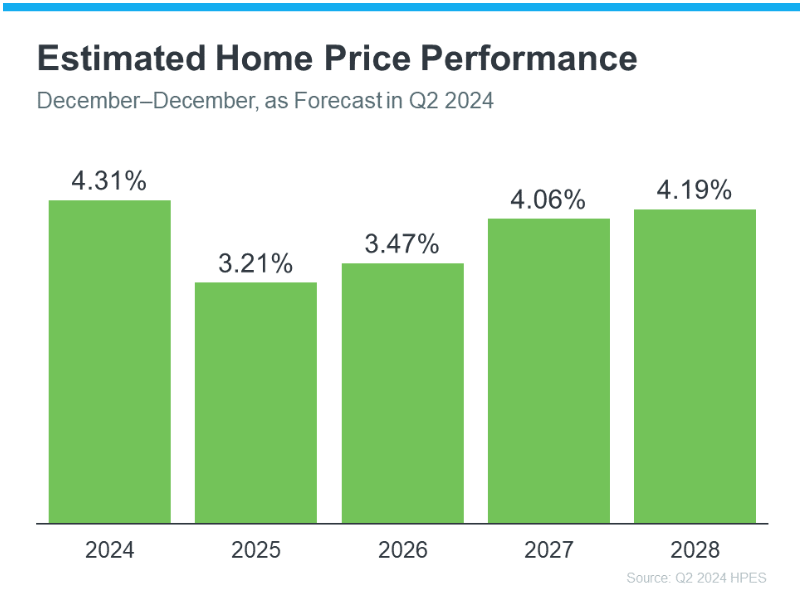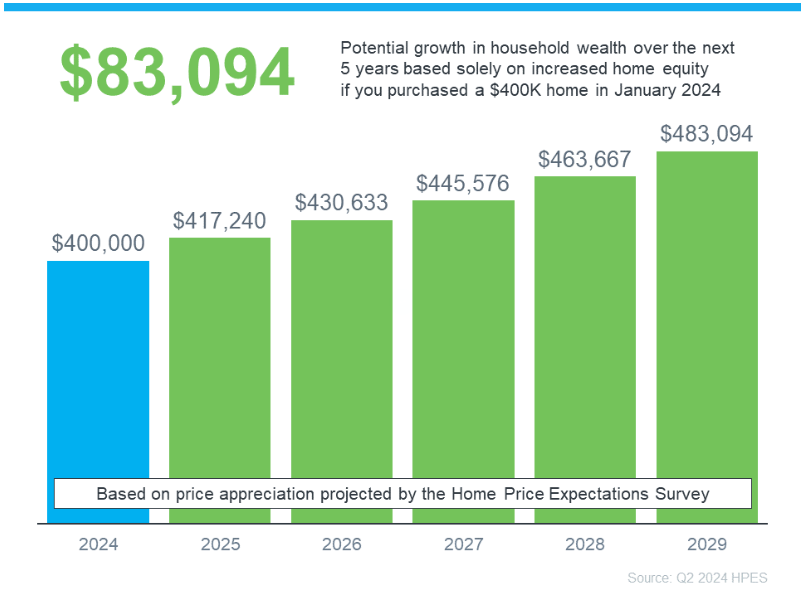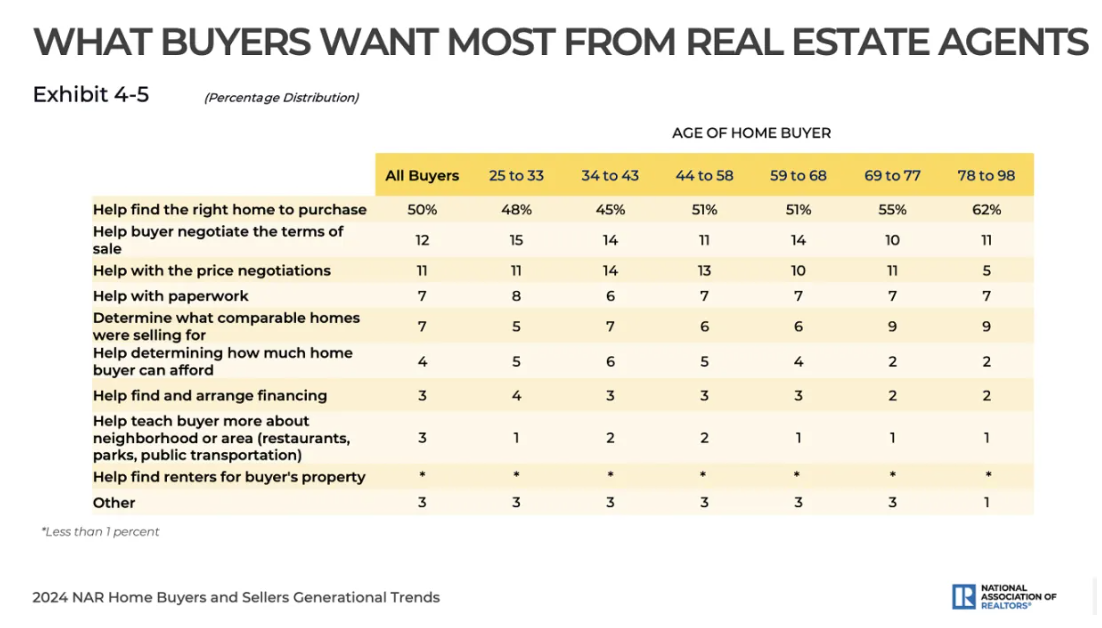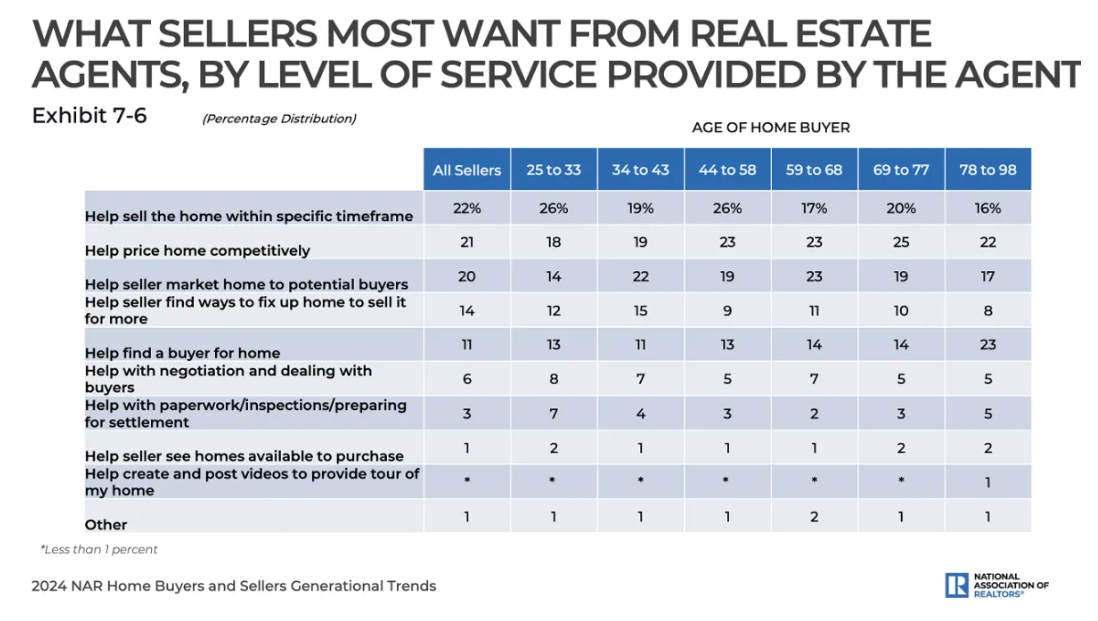Buying a home? 111 reasons to use a buyer’s agent
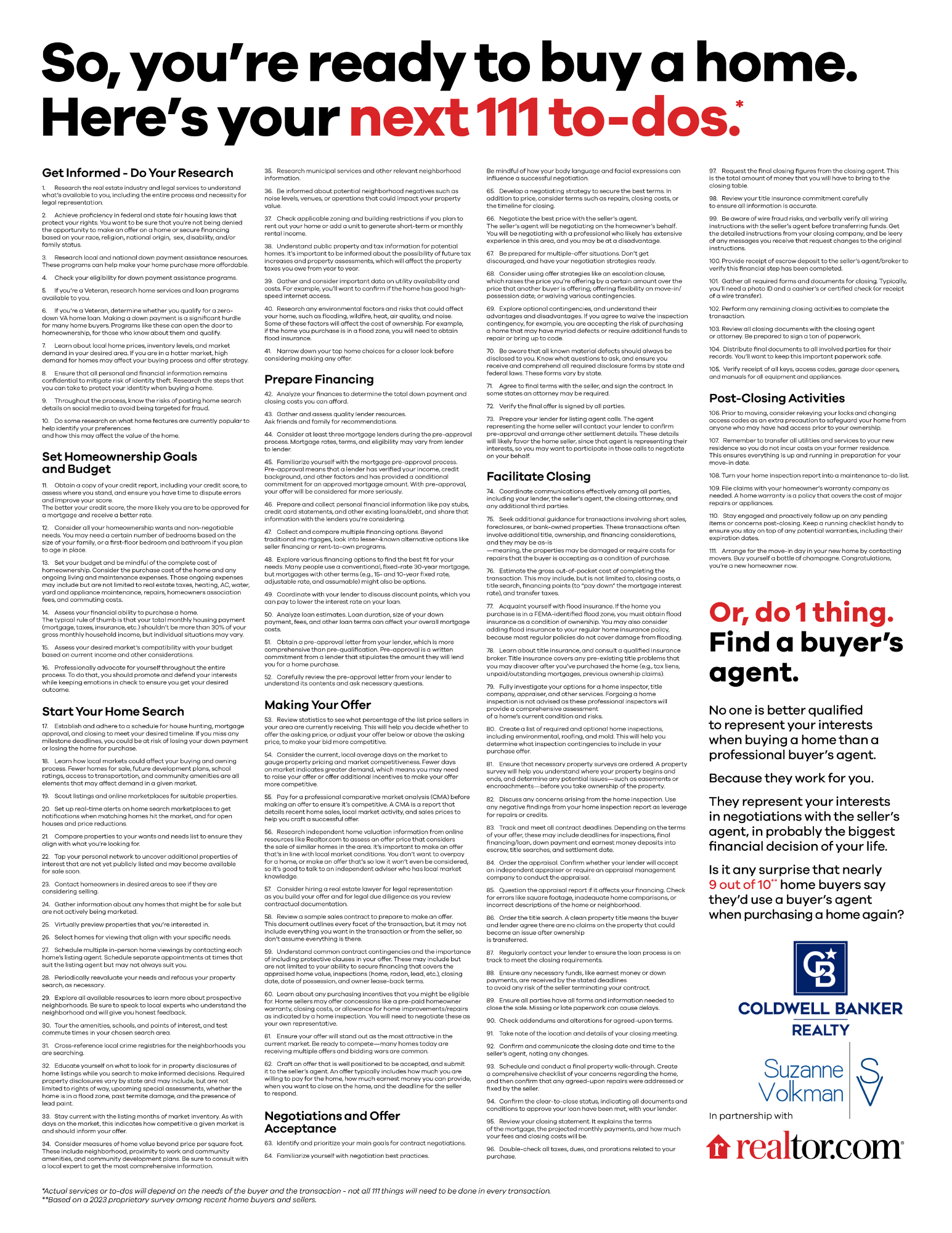
So, you’re ready to buy a home.
Here’s your next 111 to-dos.
*
Get Informed – Do Your Research
1. Research the real estate industry and legal services to understand what’s available to you, including the entire process and necessity for legal representation.
2. Achieve proficiency in federal and state fair housing laws that protect your rights. You want to be sure that you’re not being denied the opportunity to make an offer on a home or secure financing based on your race, religion, national origin, sex, disability, and/or family status.
3. Research local and national down payment assistance resources. These programs can help make your home purchase more affordable.
4. Check your eligibility for down payment assistance programs.
5. If you’re a Veteran, research home services and loan programs available to you.
6. If you’re a Veteran, determine whether you qualify for a zero-down VA home loan. Making a down payment is a significant hurdle for many home buyers. Programs like these can open the door to homeownership, for those who know about them and qualify.
7. Learn about local home prices, inventory levels, and market demand in your desired area. If you are in a hotter market, high demand for homes may affect your buying process and offer strategy.
8. Ensure that all personal and financial information remains confidential to mitigate risk of identity theft. Research the steps that you can take to protect your identity when buying a home.
9. Throughout the process, know the risks of posting home search details on social media to avoid being targeted for fraud.
10. Do some research on what home features are currently popular to help identify your preferences and how this may affect the value of the home.
Set Homeownership Goals and Budget
11. Obtain a copy of your credit report, including your credit score, to assess where you stand, and ensure you have time to dispute errors and improve your score. The better your credit score, the more likely you are to be approved for a mortgage and receive a better rate.
12. Consider all your homeownership wants and non-negotiable needs. You may need a certain number of bedrooms based on the size of your family, or a first-floor bedroom and bathroom if you plan to age in place.
13. Set your budget and be mindful of the complete cost of homeownership. Consider the purchase cost of the home and any ongoing living and maintenance expenses. Those ongoing expenses may include but are not limited to real estate taxes, heating, AC, water, yard and appliance maintenance, repairs, homeowners association fees, and commuting costs.
14. Assess your financial ability to purchase a home. The typical rule of thumb is that your total monthly housing payment (mortgage, taxes, insurance, etc.) shouldn’t be more than 30% of your gross monthly household income, but individual situations may vary.
15. Assess your desired market’s compatibility with your budget based on current income and other considerations.
16. Professionally advocate for yourself throughout the entire process. To do that, you should promote and defend your interests while keeping emotions in check to ensure you get your desired outcome.
Start Your Home Search
17. Establish and adhere to a schedule for house hunting, mortgage approval, and closing to meet your desired timeline. If you miss any milestone deadlines, you could be at risk of losing your down payment or losing the home for purchase.
18. Learn how local markets could affect your buying and owning process. Fewer homes for sale, future development plans, school ratings, access to transportation, and community amenities are all elements that may affect demand in a given market.
19. Scout listings and online marketplaces for suitable properties.
20. Set up real-time alerts on home search marketplaces to get notifications when matching homes hit the market, and for open houses and price reductions.
21. Compare properties to your wants and needs list to ensure they align with what you’re looking for.
22. Tap your personal network to uncover additional properties of interest that are not yet publicly listed and may become available for sale soon.
23. Contact homeowners in desired areas to see if they are considering selling.
24. Gather information about any homes that might be for sale but are not actively being marketed.
25. Virtually preview properties that you’re interested in.
26. Select homes for viewing that align with your specific needs.
27. Schedule multiple in-person home viewings by contacting each home’s listing agent. Schedule separate appointments at times that suit the listing agent but may not always suit you.
28. Periodically reevaluate your needs and refocus your property search, as necessary.
29. Explore all available resources to learn more about prospective neighborhoods. Be sure to speak to local experts who understand the neighborhood and will give you honest feedback.
30. Tour the amenities, schools, and points of interest, and test commute times in your chosen search area.
31. Cross-reference local crime registries for the neighborhoods you are searching.
32. Educate yourself on what to look for in property disclosures of home listings while you search to make informed decisions. Required property disclosures vary by state and may include, but are not limited to rights of way, upcoming special assessments, whether the home is in a flood zone, past termite damage, and the presence of lead paint.
33. Stay current with the listing months of market inventory. As with days on the market, this indicates how competitive a given market is and should inform your offer.
34. Consider measures of home value beyond price per square foot. These include neighborhood, proximity to work and community amenities, and community development plans. Be sure to consult with a local expert to get the most comprehensive information.
35. Research municipal services and other relevant neighborhood information.
36. Be informed about potential neighborhood negatives such as noise levels, venues, or operations that could impact your property value.
37. Check applicable zoning and building restrictions if you plan to rent out your home or add a unit to generate short-term or monthly rental income.
38. Understand public property and tax information for potential homes. It’s important to be informed about the possibility of future tax increases and property assessments, which will affect the property taxes you owe from year to year.
39. Gather and consider important data on utility availability and costs. For example, you’ll want to confirm if the home has good high-speed internet access.
40. Research any environmental factors and risks that could affect your home, such as flooding, wildfire, heat, air quality, and noise. Some of these factors will affect the cost of ownership. For example, if the home you purchase is in a flood zone, you will need to obtain flood insurance.
41. Narrow down your top home choices for a closer look before considering making any offer.
Prepare Financing
42. Analyze your finances to determine the total down payment and closing costs you can afford.
43. Gather and assess quality lender resources. Ask friends and family for recommendations.
44. Consider at least three mortgage lenders during the pre-approval process. Mortgage rates, terms, and eligibility may vary from lender to lender.
45. Familiarize yourself with the mortgage pre-approval process. Pre-approval means that a lender has verified your income, credit background, and other factors and has provided a conditional commitment for an approved mortgage amount. With pre-approval, your offer will be considered far more seriously.
46. Prepare and collect personal financial information like pay stubs, credit card statements, and other existing loans/debt, and share that information with the lenders you’re considering.
47. Collect and compare multiple financing options. Beyond traditional mortgages, look into lesser-known alternative options like seller financing or rent-to-own programs.
48. Explore various financing options to find the best fit for your needs. Many people use a conventional, fixed-rate 30-year mortgage, but mortgages with other terms (e.g., 15- and 10-year fixed rate, adjustable rate, and assumable) might also be options.
49. Coordinate with your lender to discuss discount points, which you can pay to lower the interest rate on your loan.
50. Analyze loan estimates. Loan duration, size of your down payment, fees, and other loan terms can affect your overall mortgage costs.
51. Obtain a pre-approval letter from your lender, which is more comprehensive than pre-qualification. Pre-approval is a written commitment from a lender that stipulates the amount they will lend you for a home purchase.
52. Carefully review the pre-approval letter from your lender to understand its contents and ask necessary questions.
Making Your Offer
53. Review statistics to see what percentage of the list price sellers in your area are currently receiving. This will help you decide whether to offer the asking price, or adjust your offer below or above the asking price, to make your bid more competitive.
54. Consider the current, local average days on the market to gauge property pricing and market competitiveness. Fewer days on market indicates greater demand, which means you may need to raise your offer or offer additional incentives to make your offer more competitive.
55. Pay for a professional comparative market analysis (CMA) before making an offer to ensure it’s competitive. A CMA is a report that details recent home sales, local market activity, and sales prices to help you craft a successful offer.
56. Research independent home valuation information from online resources like Realtor.com to assess an offer price that considers the sale of similar homes in the area. It’s important to make an offer that’s in line with local market conditions. You don’t want to overpay for a home, or make an offer that’s so low it won’t even be considered, so it’s good to talk to an independent adviser who has local market knowledge.
57. Consider hiring a real estate lawyer for legal representation as you build your offer and for legal due diligence as you review contractual documentation.
58. Review a sample sales contract to prepare to make an offer. This document outlines every facet of the transaction, but it may not include everything you want in the transaction or from the seller, so don’t assume everything is there.
59. Understand common contract contingencies and the importance of including protective clauses in your offer. These may include but are not limited to your ability to secure financing that covers the appraised home value, inspections (home, radon, lead, etc.), closing date, date of possession, and owner lease-back terms.
60. Learn about any purchasing incentives that you might be eligible for. Home sellers may offer concessions like a pre-paid homeowner warranty, closing costs, or allowance for home improvements/repairs as indicated by a home inspection. You will need to negotiate these as your own representative.
61. Ensure your offer will stand out as the most attractive in the current market. Be ready to compete—many homes today are receiving multiple offers and bidding wars are common.
62. Craft an offer that is well positioned to be accepted, and submit it to the seller’s agent. An offer typically includes how much you are willing to pay for the home, how much earnest money you can provide, when you want to close on the home, and the deadline for the seller to respond.
Negotiations and Offer Acceptance
63. Identify and prioritize your main goals for contract negotiations.
64. Familiarize yourself with negotiation best practices. Be mindful of how your body language and facial expressions can influence a successful negotiation.
65. Develop a negotiating strategy to secure the best terms. In addition to price, consider terms such as repairs, closing costs, or the timeline for closing.
66. Negotiate the best price with the seller’s agent. The seller’s agent will be negotiating on the homeowner’s behalf. You will be negotiating with a professional who likely has extensive experience in this area, and you may be at a disadvantage.
67. Be prepared for multiple-offer situations. Don’t get discouraged, and have your negotiation strategies ready.
68. Consider using offer strategies like an escalation clause, which raises the price you’re offering by a certain amount over the price that another buyer is offering; offering flexibility on move-in/possession date; or waiving various contingencies.
69. Explore optional contingencies, and understand their advantages and disadvantages. If you agree to waive the inspection contingency, for example, you are accepting the risk of purchasing a home that may have myriad defects or require additional funds to repair or bring up to code.
70. Be aware that all known material defects should always be disclosed to you. Know what questions to ask, and ensure you receive and comprehend all required disclosure forms by state and federal laws. These forms vary by state.
71. Agree to final terms with the seller, and sign the contract. In some states an attorney may be required.
72. Verify the final offer is signed by all parties.
73. Prepare your lender for listing agent calls. The agent representing the home seller will contact your lender to confirm pre-approval and arrange other settlement details. These details will likely favor the home seller, since that agent is representing their interests, so you may want to participate in those calls to negotiate on your behalf.
Facilitate Closing
74. Coordinate communications effectively among all parties, including your lender, the seller’s agent, the closing attorney, and any additional third parties.
75. Seek additional guidance for transactions involving short sales, foreclosures, or bank-owned properties. These transactions often involve additional title, ownership, and financing considerations, and they may be as-is—meaning, the properties may be damaged or require costs for repairs that the buyer is accepting as a condition of purchase.
76. Estimate the gross out-of-pocket cost of completing the transaction. This may include, but is not limited to, closing costs, a title search, financing points (to “pay down” the mortgage interest rate), and transfer taxes.
77. Acquaint yourself with flood insurance. If the home you purchase is in a FEMA-identified flood zone, you must obtain flood insurance as a condition of ownership. You may also consider adding flood insurance to your regular home insurance policy, because most regular policies do not cover damage from flooding.
78. Learn about title insurance, and consult a qualified insurance broker. Title insurance covers any pre-existing title problems that you may discover after you’ve purchased the home (e.g., tax liens, unpaid/outstanding mortgages, previous ownership claims).
79. Fully investigate your options for a home inspector, title company, appraiser, and other services. Forgoing a home inspection is not advised as these professional inspectors will provide a comprehensive assessment of a home’s current condition and risks.
80. Create a list of required and optional home inspections, including environmental, roofing, and mold. This will help you determine what inspection contingencies to include in your purchase offer.
81. Ensure that necessary property surveys are ordered. A property survey will help you understand where your property begins and ends, and determine any potential
issues—such as easements or encroachments—before you take ownership of the property.
82. Discuss any concerns arising from the home inspection. Use any negative findings from your home inspection report as leverage for repairs or credits.
83. Track and meet all contract deadlines. Depending on the terms of your offer, these may include deadlines for inspections, final financing/loan, down payment and earnest money deposits into escrow, title searches, and settlement date.
84. Order the appraisal. Confirm whether your lender will accept an independent appraiser or require an appraisal management company to conduct the appraisal.
85. Question the appraisal report if it affects your financing. Check for errors like square footage, inadequate home comparisons, or incorrect descriptions of the home or
neighborhood.
86. Order the title search. A clean property title means the buyer and lender agree there are no claims on the property that could become an issue after ownership
is transferred.
87. Regularly contact your lender to ensure the loan process is on track to meet the closing requirements.
88. Ensure any necessary funds, like earnest money or down payments, are received by the stated deadlines to avoid any risk of the seller terminating your contract.
89. Ensure all parties have all forms and information needed to close the sale. Missing or late paperwork can cause delays.
90. Check addendums and alterations for agreed-upon terms.
91. Take note of the location and details of your closing meeting.
92. Confirm and communicate the closing date and time to the seller’s agent, noting any changes.
93. Schedule and conduct a final property walk-through. Create a comprehensive checklist of your concerns regarding the home, and then confirm that any agreed-upon repairs were addressed or fixed by the seller.
94. Confirm the clear-to-close status, indicating all documents and conditions to approve your loan have been met, with your lender.
95. Review your closing statement. It explains the terms
of the mortgage, the projected monthly payments, and how much your fees and closing costs will be.
96. Double-check all taxes, dues, and prorations related to your purchase.
97. Request the final closing figures from the closing agent. This is the total amount of money that you will have to bring to the closing table.
98. Review your title insurance commitment carefully to ensure all information is accurate.
99. Be aware of wire fraud risks, and verbally verify all wiring instructions with the seller’s agent before transferring funds. Get the detailed instructions from your closing company, and be leery of any messages you receive that request changes to the original instructions.
100.Provide receipt of escrow deposit to the seller’s agent/broker to verify this financial step has been completed.
101. Gather all required forms and documents for closing. Typically, you’ll need a photo ID and a cashier’s or certified check (or receipt of a wire transfer).
102. Perform any remaining closing activities to complete the transaction.
103.Review all closing documents with the closing agent or attorney. Be prepared to sign a ton of paperwork.
104. Distribute final documents to all involved parties for their records. You’ll want to keep this important paperwork safe.
105. Verify receipt of all keys, access codes, garage door openers, and manuals for all equipment and appliances.
Post-Closing Activities
106.Prior to moving, consider rekeying your locks and changing access codes as an extra precaution to safeguard your home from anyone who may have had access prior to your ownership.
107. Remember to transfer all utilities and services to your new residence so you do not incur costs on your former residence. This ensures everything is up and running in preparation for your move-in date.
108.Turn your home inspection report into a maintenance to-do list.
109.File claims with your homeowner’s warranty company as needed. A home warranty is a policy that covers the cost of major repairs or appliances.
110. Stay engaged and proactively follow up on any pending items or concerns post-closing. Keep a running checklist handy to ensure you stay on top of any potential warranties, including their expiration dates.
111. Arrange for the move-in day in your new home by contacting movers. Buy yourself a bottle of champagne. Congratulations, you’re a new homeowner now.
Or, do 1 thing.
Find a buyer’s agent.
No one is better qualified to represent your interests when buying a home than a professional buyer’s agent.
Because they work for you.
They represent your interests in negotiations with the seller’s agent, in probably the biggest financial decision of your life.
Is it any surprise that nearly 9 out of 10** home buyers say they’d use a buyer’s agent when purchasing a home again?
*Actual services or to-dos will depend on the needs of the buyer and the transaction – not all 111 things will need to be done in every transaction.
**Based on a 2023 proprietary survey among recent home buyers and sellers.
California REALTORS® place open letter in California newspapers to mitigate confusion about pending changes in industry business practices

“If you’ve been reading about real estate lately, you’ve no doubt heard about antitrust lawsuits and settlements by real estate brokerages and the National Association of REALTORS®. You’ve also heard about the settlements resulting in certain changes in how agents will be compensated for their work,” C.A.R. President Melanie Barker said in the letter. “Recent coverage by media entities, industry insiders and anyone with an opinion and a smartphone have offered up a mix of fact and fiction. All this noise has caused confusion, fear and, in some instances, panic about the process of buying and selling a home.”
The letter outlines the two major changes resulting from the litigation settlement. 1) Properties listed in databases known as the multiple listing service (MLS) will no longer be allowed to include an offer of compensation to buyer’s agents and 2) Homebuyers who want to work with an agent will need to sign a written agreement with that agent prior to touring a home. This means before consumers start their home search, they’ll need to discuss and agree with their agent what the agent will do on their behalf, and they’ll need to decide how much and how to pay that agent.
In fact, C.A.R. has supported transparency with respect to how buyer’s agents are compensated for more than two decades since the Association introduced its first buyer representation agreement in 1999. C.A.R. introduced its most recent Buyer Representation and Broker Compensation Agreement in December 2022.
Read the full letter below:

Dear Californians,
If you’ve been reading about real estate lately, you’ve no doubt heard about antitrust lawsuits and settlements by real estate brokerages and the National Association of REALTORS®. You’ve also heard about the settlements resulting in certain changes in how agents will be compensated for their work. Recent coverage by media entities, industry insiders and anyone with an opinion and a smartphone have offered up a mix of fact and fiction. All this noise has caused confusion, fear and, in some instances, panic about the process of buying and selling a home.
We thought it time to speak directly to you. We’re California REALTORS®, and we know a thing or two about real estate. In fact, it’s precisely because of our knowledge about the complexities of what is arguably the most important purchase people make in their lives that we want to say this first: It’ll be okay. Yes, some real estate practices will change as a result of these settlements, but California REALTORS® know how to adapt to changing market realities. We always have. And, while we understand that uncertainty can be deeply unsettling, especially when there are few answers and many opinions, we know we’ll figure it out together, as an industry and with our clients.
Here’s the bottom line: The two major changes resulting from this litigation are 1. Properties listed in databases known as the multiple listing service (MLS) will no longer be allowed to include an offer of compensation to buyer’s agents and 2. Homebuyers who want to work with an agent will need to sign a written agreement with that agent prior to touring a home. This means before you start your home search, you’ll need to discuss and agree with your agent what the agent will do on your behalf, and you’ll need to decide how much and how to pay that agent.
Of course, it’s not that simple. How consumers work with agents in this new environment will need to work itself out, and there will be differing approaches between agents and their clients. Many in the industry, and we at the CALIFORNIA ASSOCIATION OF REALTORS® (C.A.R.), are currently working on sorting through and articulating those new practices as quickly as possible. Moreover, in California, we have supported transparency with respect to how buyer’s agents get compensated for more than two decades, since C.A.R. introduced its first buyer representation agreement in 1999. So, while the implementation of practice changes resulting from this settlement may be new, the spirit behind them is not — at least not in California. We’re all for transparency because we believe it’s in our clients’ best interests and we know the value we bring to the transaction.
We’re in this business because we believe in putting people not just in houses, but in homes. You may regard us as the organization that fights to protect homeowners’ rights. That’s true. But more likely, you know us because we’re your neighbors. We live in the same communities as you. We volunteer alongside you at our kids’ schools, we show up to serve at local civic and charitable organizations, and we sit on city councils to make our communities better. And while we’re known as the neighborhood experts, we’re also trained in all facets of a real estate transaction, meaning we know what it takes to successfully conduct a home purchase or sale. Our jobs are far more involved — and far less glamorous — than what you see on real estate “reality” shows. The truth is that real estate transactions are complicated. That’s why we have to be well-versed in myriad financial and legal requirements in order to guide you through such a complex process. We negotiate on our buyers’ behalf to get them the right home at the right price, and we help sellers determine the best listing price based on market and neighborhood fundamentals. We guide our clients through the nitty-gritty of home inspections and innumerable other details, and we support our clients through what can be a stressful time. We come to this job because we love putting people in homes. We stay in this job because we love working with our clients, who become our friends and neighbors.
As we’ve done for decades, through up markets and down markets, through periods of industry change, we will stand by our clients, serve our communities, and continue to do what we do best — work to create a future that enables homeownership for all who want it. Sincerely,
Melanie Barker
2024 President
California Association of REALTORS®
More home sellers are paying capital gains taxes — here’s how to reduce your bill

More Americans are paying capital gains taxes on home sale profits amid soaring property values — but there are ways to reduce your bill, experts say.
In 2023, nearly 8% of U.S. home sales yielded profits exceeding $500,000, compared with about 3% in 2019, according to an April report from real estate data firm CoreLogic.
It’s key for a special tax break for homeowners who make a profit when selling a primary residence. Married couples filing together can make up to $500,000 on the sale without owing capital gains taxes. The threshold for single filers is $250,000.
Those capital gains exemption thresholds haven’t been indexed for inflation since 1997, said certified financial planner Jaime Quinones with Stockade Wealth Management in Marlboro, New Jersey.
“With the recent rise in home values, more sellers have been facing a capital gains tax hit,” Quinones said.
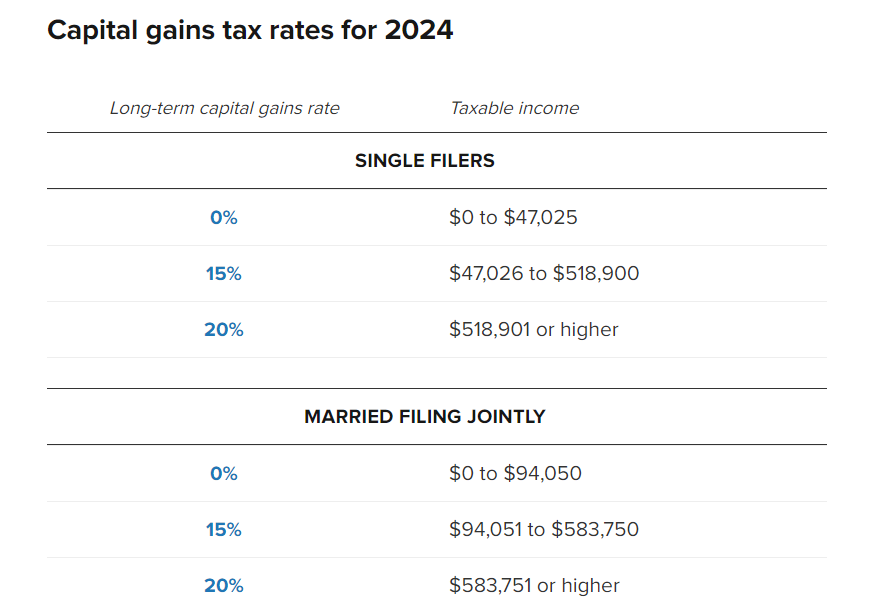
Home sale profits above the $250,000 or $500,000 thresholds incur capital gains taxes of 0%, 15% or 20%, depending on your income.
Capital gains taxes on a home sale are more common in high-cost areas. In 2023, the percentage of home sales that had profits exceeding $500,000 hit double digits in Colorado, Massachusetts, New Jersey, New York and Washington, the CoreLogic report found.
How to qualify for the capital gains exemption
The IRS has strict rules for qualifying for the $250,000 or $500,000 capital gains exemption, according to the IRS. To that point, you must own the home for at least two of the past five years before your home sale to satisfy the “ownership test.”
The “residence test” says the home must be your primary residence for any 24 months of the five years before the sale, with some exceptions. The 24 months don’t need to be consecutive.
How to reduce your capital gains tax bill
If you’ve lived in a home long enough to exceed the capital gains exemptions, there’s a “high probability” you’ve made improvements to the home, said Falls Church, Virginia-based CFP Parker Trasborg, senior financial advisor at CJM Wealth Advisers.
You can use those improvements to increase your home’s “basis,” or original purchase price, which reduces your profit, he said.
But routine maintenance and repairs don’t count. For example, you can increase your home’s basis by adding the cost of a new roof or addition. But fixes to leaky pipes won’t qualify.
After selling a home, the IRS receives Form 1099-S, which shows your closing date and gross proceeds. But you’ll need paperwork to prove any changes to your home’s basis in the case of an IRS audit.
PUBLISHED TUE, MAY 7 2024
7 Types of Tax-Deductible Home Improvements
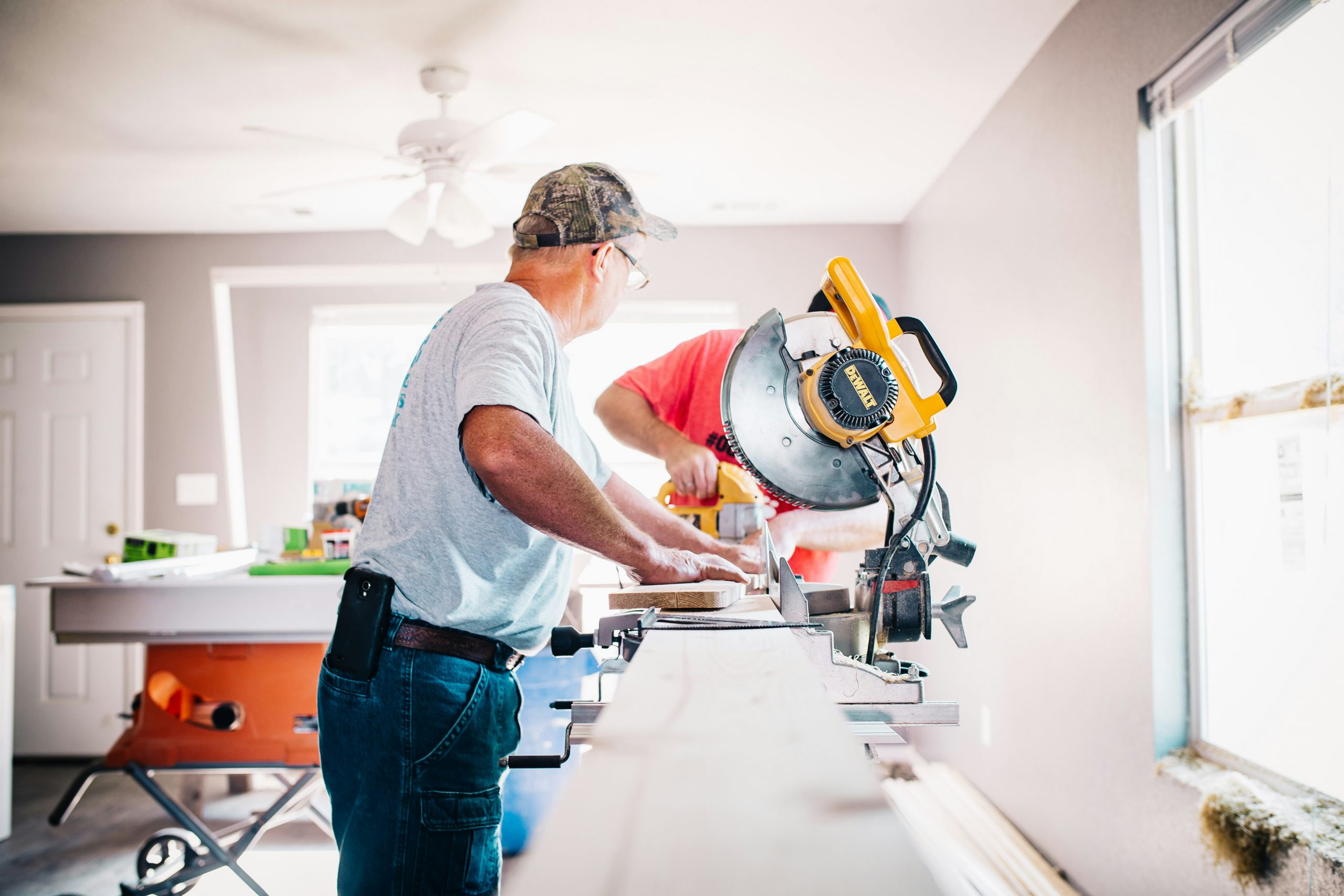
Here’s an overview of a few examples of tax-deductible home improvements. As always, you should consult a tax professional to understand more about what qualifies for deductions.
Energy-Efficient Upgrades
Homeowners can potentially qualify for an Energy Efficiency Home Improvement Credit of up to $3,200 for energy-efficient improvements made after Jan. 1, 2023. The credit for 2024 is 30% of qualified expenses, but it has certain limits depending on the type of improvement.
Energy efficient upgrades can help reduce energy usage and strain on a home’s critical systems. Upgrades can include structural improvements to the home and the installation of new systems. Here are some sample projects:
- A home energy audit may be eligible for a tax credit of up to $150. An auditor will help your clients understand where they’re losing energy and identify health and safety issues in their home. A home energy audit could help save up to 30% on energy bills, according to the Department of Energy. To qualify for the credit, the audit must be conducted by a qualified home energy auditor or someone who is supervised by a qualified auditor. It also must include a written report prepared and signed by a qualified home energy auditor, and the report must be consistent with industry best practices. Find more information in Notice 2023-59.
- Install ENERGY STAR’s Most Efficient exterior windows and skylights for a credit of up to $600 based upon eligibility. Replacing windows can help improve insulation and reduce the need to run the HVAC system.
- Install biomass stoves that meet ENERGY STAR’s requirements for up to a $2,000 credit. Biomass stoves must have a thermal efficiency rating of at least 75% to qualify, and costs may include labor to install. Biomass can consist of wood pellets and grasses. Although burning biomass can reduce energy usage, insurance experts recommend following wood-burning best practices to help reduce fire and other health risks.
Clean Energy Upgrades
Homeowners could potentially qualify for the Residential Clean Energy Credit if they install new renewable energy properties in their homes. There is no dollar limit for this credit except for fuel cell properties ($500 for each half-kilowatt of capacity).
Using clean energy can help lower reliance on traditional utilities and lower usage and bills. Systems like solar panels are generally easy to maintain, typically only requiring regular cleaning to prevent debris buildup. Here are some sample projects:
- Installing a solar water heater can help reduce strain on a traditional water heater and help prolong its life, depending on the type installed. For example, a two-tank solar water heater preheats water before it reaches a traditional water heater. Water heating is typically the second largest energy expense in any home.
- Installing geothermal heat pumps can help heat and cool a home more efficiently than traditional heating and cooling systems by transferring heat to the ground rather than generating heat. They tend to be expensive, but according to the Department of Energy, it could potentially see a return on investment for homeowners in five to 10 years depending on available financial incentives.
- Battery storage technology helps store excess energy generated from clean energy sources. This gives a home a reliable energy source if the grid goes down.
Historic Home Upgrades
The Federal Historic Rehabilitation Tax Credit could apply if homeowners are undergoing a renovation of a historic home. Historic homes can qualify for this tax credit and other grants since many organizations wish to preserve historical buildings. Taking advantage of these can help lower the financial burden of potential repairs while helping to restore a home’s original beauty. Here are some sample projects:
- Upgrading or replacing old pipes may qualify for this tax credit and may be necessary to bring the home up to code and help prevent water damage.
- Replacing deteriorated parts in the structure of a home, like posts or beams, may qualify for this credit. Replacement should be visually similar to the original and at least equal to the original’s load-bearing capabilities.
- Fully replacing a deteriorating set of stairs using the same or compatible substitute material can make a home safer and also may qualify for this tax credit. The new set of stairs should look similar to the original.
Medically Necessary Upgrades
Homeowners could potentially include medically necessary home upgrades as a part of a medical expense deduction. These include improvements that help make a home more accommodating for a person with a disability, spouse or dependents that live in the home. The amount that can be included in a medical expense deduction depends on how the improvement impacts the home’s value:
- If the home’s value increases as a result of the improvement, the medical expense is considered the cost of the improvement minus the increase in home value.
- If the home’s value does not increase, it can include the entire cost in the medical expense deduction.
Homeowners can invest in upgrades that can help make their home more accessible and help prevent future maintenance issues (which is especially important if they plan to age in place). For example, lowering kitchen cabinets or installing pull-down shelves can help prevent potential falls and damage when straining for out-of-reach items. Here are some sample projects:
- Installing modified smoke detectors and other monitoring systems can help alert those with a disability, like alarms with strobe lights for those who are hard of hearing. Smart monitoring systems, like water leak detectors, can also make it easier to detect issues early in hard-to-reach areas.
- Grading, or leveling, the ground can improve accessibility and also help protect a home from water runoff. Grading can help reduce steep slopes and create more accessible pathways for those with mobility challenges. It can also help direct runoff away from a home and prevent standing water.
- Bathroom modifications, like grab bars and railings, can help prevent slips and falls. These modifications also can help prevent water splashes that could lead to mold or mildew over time.
Home Office Repairs and Improvements
Homeowners may be eligible to deduct home office repair expenses if they have a dedicated part of their home that they regularly use as their main place of business. The amount that can be deducted depends on whether the project impacts the entire home or just the office. Home office improvements are not tax deductible and would be categorized similarly to capital improvements. Here are some sample projects:
- If installing a full home security system, homeowners could potentially deduct the cost of maintaining and monitoring the system that relates to the business part of their home.
- Repairing damaged outlets and wiring may be tax deductible and, more importantly, a crucial project to help prevent electrical fires and potential damage to devices. Electrical distribution or lighting equipment (which includes wiring and outlets) was the leading cause of home property damage from 2016 to 2020, according to the April 2023 National Fire Protection Association Home Structure Fires Report.
- Replacing home office windows with dual or triple-pane windows to help improve insulation and reduce noise also may be eligible. In addition to the tax benefits, homeowners may find it good for resale value, too, since this can help lower the need for cooling and heating and lower the strain on an HVAC system.
Rental Property Repairs
If homeowners rent out a part of their home, they may be able to deduct repair expenses from the amount of taxable rental income they receive. Limitations apply, such as if they’re renting a space in their current residence.
Maintaining the parts of their home that they rent can help prevent issues from impacting the rest of their home. For example, issues like water leaks or drafts in one area can lead to bigger issues if left unaddressed. Here are some sample projects:
- Repairing leaks in a tenant’s bathroom can help prevent long-term mold and mildew issues. Leaks also could impact a home’s structural integrity if drywall or floor joists are left wet over time.
- Addressing air leaks in a tenant’s area can help improve insulation, keep them comfortable and lower the need to cool or heat that part of a home. Updating the weather stripping around windows and doors may also apply.
- Routinely checking the air vents in a tenant’s part of the home can improve the chances of catching airflow issues early, including dirty vents or leaky ducts. Improved airflow can help boost indoor air quality and regulate temperature throughout your home.
Capital Improvements
Capital improvements are projects that extend a home’s life, add value or refit a home for new uses. These differ from home repairs, which are part of property maintenance but don’t necessarily add value (like fixing a leak). There are some limitations to the types of eligible improvements. For example, homeowners cannot include the cost of installing carpeting if they later remove it. They also cannot include energy-related improvements if they received subsidies or tax credits for those improvements.
Homeowners can add the value of qualifying capital improvements to the cost basis of their home. When they sell their home one day, they may be able to subtract their adjusted cost basis from the sale price. This can help reduce the amount of capital gains taxes they may owe. However, they’ll also need to take into account the tax implications of the capital gains from the sale of their home.
Although homeowners won’t see tax benefits from these improvements right away, these projects can help proactively protect a home by getting ahead of potential issues. Here are some sample projects:
- Installing a new HVAC system to replace one that’s over 10 to 25 years old, isn’t running efficiently or is worn beyond repair can help save money and help protect a home. A modern and efficient HVAC system can improve air circulation, maintain temperature control, and help cut down on utility costs in the process.
- Installing attic insulation can cost about $1.80 per square foot and can help reduce heating and cooling costs, easing stress on an HVAC system. A better-insulated attic can also help maintain a roof’s temperature and prevent related damage, like the expanding and contracting that can occur with winter ice dams.
- Installing water softeners can help reduce calcium and magnesium in the water. This helps reduce buildup in plumbing fixtures and pipes and helps appliances run more efficiently and last longer.
By Courtney Klosterman, home insights expert and director of communications at Hippo Insurance
Let Your Home Equity Fund Your Retirement

Struggling with Money? Learn about Home Equity Conversion Mortgages (HECMs)
If you’re low on cash, you might consider a Home Equity Conversion Mortgage (HECM). It’s like a reverse mortgage backed by the government. This means if you meet certain requirements, you can borrow money against the value of your home. The Federal Housing Administration (FHA) guarantees repayment to the lender, so it’s secure. In recent years, HECMs have become more popular, especially among older folks who need extra cash and plan to stay in their homes forever.
Understanding HECM Rules
To qualify for an HECM, you need to be at least 62 years old. Also, you’ll have to pay back the loan when you move out, sell your house, or pass away. You must own your home or have a significant portion paid off, and it must be your primary residence. Plus, you’ll need to have a session with a counselor approved by the Department of Housing and Urban Development (HUD).
Limits and Considerations
The amount you can borrow depends on factors like your age, current interest rates, and the value of your home. Typically, older homeowners with more valuable properties can borrow more.
HECM vs. Regular Mortgages
Unlike traditional mortgages, with HECMs, the amount you owe increases over time. You’ll still need to cover property taxes, insurance, and upkeep costs. Also, the interest you pay isn’t tax-deductible until you pay off the loan.
How You Get Paid
You can choose to receive HECM funds as a lump sum or in monthly payments or a line of credit. You’re free to use the money as you wish, whether for essential expenses, paying off debts, or enjoying life.
HECMs offer a flexible way to access cash when you need it, especially for retirees looking to boost their income.
Attractive features
An HECM offers some compelling advantages if your circumstances fit:
- You can plan on staying in your “forever” home, where you are settled, and can perhaps renovate it, allowing you to age in place.
- You can enjoy a reliable cash flow in order to provide more comfortable senior years.
- You need not make monthly payments on the loan balance.
- Your spouse can usually remain in the home even if you die or move to another accommodation.
- You can pay off debt balances, such as medical bills.
- You can use the proceeds to pay off existing mortgages and thereby prevent foreclosures.
- You can avoid paying withdrawal penalties on other retirement accounts.
- You can fund a grandchild’s education or any other meaningful purpose.
- Integrated protections limit your heirs’ responsibilities.
But is it right for you?
There are several significant drawbacks, so seniors must take extra care with such an important decision:
- Fees tend to be high, including upfront financed origination charges of about 2% and around .5% for annual review of mortgage insurance premiums.
- You could compromise your benefits from needs-based programs, such as Medicaid.
- You could inadvertently default by failing to meet loan requirements, including by living outside the home most of the year, neglecting property taxes or home insurance, or not making maintenance repairs. An unresolved default might lead to eviction and foreclosure.
Alternative loans may be more appropriate. For example, those under age 62 could use home equity loans (HELOCs). More expensive properties may require a jumbo reverse mortgage, with higher interest rates but no mortgage insurance. By contrast, single-purpose reverse mortgages are cheapest and can be used for specified expenses such as taxes or repairs.
Your financial advisor can help you compare different types of reverse mortgages, payment options and other considerations.
Why 90% of Homebuyers Will Continue to Choose Working with Real Estate Agents: Insights from the National Association of Realtors

Members of the National Association of Realtors will continue to be the most reliable partner for the millions of Americans striving to realize the American dream through homeownership.
Specifically, the settlement will prohibit offers of compensation from being shared on multiple listing services (MLSs), the databases that show real estate brokers the properties for sale, and it will require MLS participants to enter into written agreements with their buyers.
These changes will go into effect in mid-late July 2024.
It’s important to note that the National Association of Realtors does not set commissions, and nothing in this proposed settlement would change that. Commissions would continue to be negotiable among buyers, sellers, and their brokers.
The “cooperative compensation” rule that has been subject to litigation says that selling brokers have to specify on each listing an offer of compensation to buyers’ brokers. That offer could be any amount, even zero.
Cooperative compensation, where the compensation a seller pays to their broker is shared, covering the cost of a buyer broker’s services, will continue to be an important option for consumers in all transactions and especially those involving lower and middle-income homebuyers, who may already have a difficult-enough time saving for a down payment.
The bottom line is that consumers will continue to be able to choose what kind of professional real estate advice they’d like–and how much, and how, they will pay for the work of a real estate professional.
Historically, nearly 90% of homebuyers have opted to work with a real estate agent or broker. That figure is unlikely to change.
Even in an era where seemingly everything can be researched and purchased electronically, the clear value added by realtors remains evident. Nine in 10 home buyers would use their agent again or recommend their agent to others.
Seasoned agents and brokers also offer insights into property values, taxes, regulations, and zoning laws while overseeing thorough due diligence processes. And we connect buyers and sellers with other reputable real estate-related professionals such as lawyers, lenders, contractors, and inspectors–any of which can make or break a transaction.
When it comes time to make or evaluate offers, real estate professionals have a decades-long track record as skilled negotiators, ensuring that their clients submit the most competitive bids for their dream home–or hold out for what their home is really worth. And at the settlement table, we help our clients confidently close on what is likely the most significant financial transaction of their lives.
Even post-sale, real estate agents and brokers are crucial advisors for their clients, providing ongoing support, answering queries, and offering guidance as people confront the challenges and delights of homeownership.
NAR’s proposed settlement agreement and the associated practice changes will not change what makes realtors valuable: specialized knowledge, diligence, and a commitment to our clients’ best interests. And it does not change the fact that millions of people will continue to rely on us to help them fulfill their dream of homeownership.
Find the original article here


 Facebook
Facebook
 X
X
 Pinterest
Pinterest
 Copy Link
Copy Link

